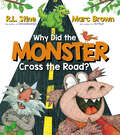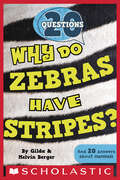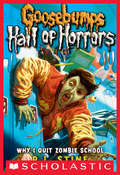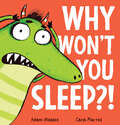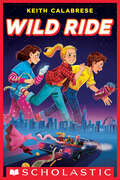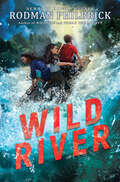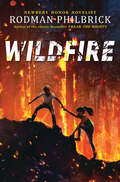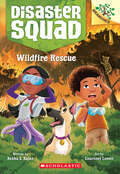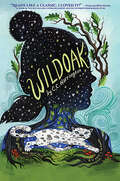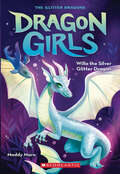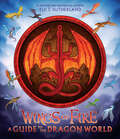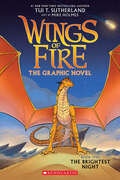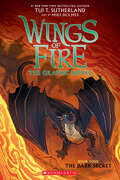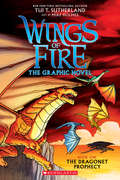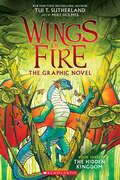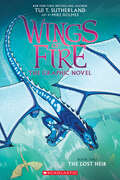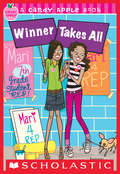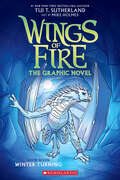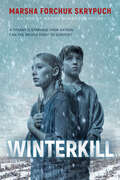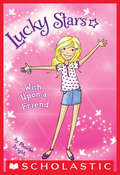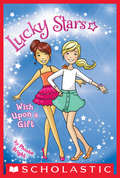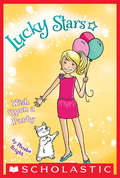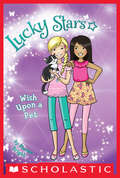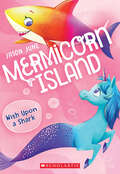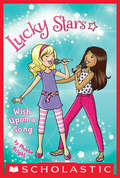- Table View
- List View
Why Did the Monster Cross the Road?
by R. L. StineFrom beloved, bestselling children's book icons, R.L. Stine and Marc Brown, comes a storybook filled with hilariously spooky jokes and fun-loving monsters that will have everyone giggling!Why did the monster cross the road?To BITE someone on the other side!Turn scary to silly with this laugh-out-loud joke book. Hunny and Funny are monster best friends. When Hunny is feeling sad, Funny knows exactly how to cheer up his friend… with laughter!Renowned bestselling children's book talents R.L. Stine, creator of the Goosebumps series, and Marc Brown, creator of the Arthur Adventure series, join forces once again in this sweet, fun-filled story that not only teaches readers hilarious jokes to share but also reminds children that laughter is the best medicine when you're feeling down. With Stine's humorous text and Brown's bold artwork, this monster-themed picture book is sure to get the monsters and furry creatures giggling all night!
Why Do Zebras Have Stripes? (20 Questions Ser. #2)
by Melvin Berger Gilda BergerThe follow-up to the fun and informative 20 Questions #1: Why Do Feet Smell?A follow-up to 20 Questions: Why Do Feet Smell? (Spring 2012) featuring fun facts about animals. Why Do Zebras Have Stripes? will ask and answer the questions about animals that kids are really curious about. Each book in the 20 questions series contains 20 questions and answers, with a full-color photograph on every page. Read the question on the right and turn the page to see the answer on the left!
Why I Quit Zombie School: Hall Of Horrors #4: Why I Quit Zombie School (Goosebumps Hall of Horrors #4)
by R. L. StineWelcome to the Hall of Horrors, HorrorLand's Hall of Fame for the truly terrifying.Poor Matt Krinsky! Not only are his parents making him move away from all of his friends, but they're enrolling him in a boarding school. It's not a strict place, but that doesn't mean things are normal. While Matt is used to be being one of the better athletes in his class, theses kids move a dead-slow pace. It's doesn't take long for him to realize that he's surrounded by zombies. And his classmates have begun to notice his heartbeat and warm skin. Can Matt convince them he is undead long enough to stay alive?
Why Won't You Sleep?!
by Adam WallaceFrom New York Times bestselling author Adam Wallace comes a side-splitting, hair-pulling bedtime story about the familiar struggles when you just can't sleep!Can't sleep? It can be hard to nod off sometimes. But don't worry, we know just the thing to make you tired... What, still awake? WHY WON'T YOU SLEEP?A hilarious story from bestselling How to Catch A series author Adam Wallace and bold, comical illustrations by Carla Martell perfectly capture the narrator's good intentions and mounting frustration as they try to get the reader to go to sleep! With plenty of gags and a funny twist at the end, this is sure to make the whole family giggle!
Wild Ride
by Keith CalabreseSwindle meets Ferris Bueller's Day Off in this action-filled comedy!No parents. No rules. No curfew.Things are about to get dangerous...The grownups are out-of-town, and for Charley Decker that means one thing: a last epic weekend with her older brother Greg before he leaves for college. Bring on the burgers, milkshakes, and movie marathons!So when Greg ditches Charley for a date night downtown, she’s kind of crushed. Worse, he gets their mom's boyfriend’s super-expensive, super-rare Mustang towed and needs Charley’s help to get it back. What's an unsupervised seventh grader to do? Grab her best friends, sneak into the city, pull off the ultimate car heist, and then make Greg pay, of course!Only now the Mustang has a new feature in the trunk: a stowaway named Mitch who’s guarding a world-changing secret. And a pair of seriously big, seriously scary dudes are after him.What follows is an all-night race around the clock as Charley and her friends try to dodge the twin terrors, save Mitch, fix a sibling squabble...and get the Mustang home before morning!
Wild River
by Rodman PhilbrickNewbery Honor author Rodman Philbrick sends readers rushing down a raging river on a life-or-death adventure when a white water rafting trip goes terribly wrong!Daniel Redmayne is fast asleep on the first night of a white water rafting trip, when he's awoken by screams. The dam has failed. The river is surging, and their camp will be under water in a matter of moments.As the shrieking roar of the river rushes closer, the kids scramble to higher ground. They make it; their counselors do not.Now they're on their own, with barely any food or supplies, in the middle of the Montana wilderness. Do Daniel and his four classmates have what it takes to stay alive until they can get rescued? Alone in the wild, they forge powerful bonds -- but develop dangerous disagreements. If nature doesn't break them, they might just destroy each other.This gripping survival story from the Newbery Honor author of Wildfire is filled with adrenaline-pumping adventure and moments of true bravery.
Wildfire (The Wild Series)
by Rodman PhilbrickNewbery Honor author Rodman Philbrick sends readers straight into the nightmare of a raging wildfire as 12-year-old Sam is trapped by explosive flames and deadly smoke that threaten to take his life. Can he survive?Flames race toward Sam Castine's summer camp as evacuation buses are loading, but Sam runs back to get his phone. Suddenly, a flash of heat blasts him as pine trees explode. Now a wall of fire separates Sam from his bus, and there's only one thing to do: Run for his life. Run or die.Lungs burning, Sam's only goal is to keep moving. Drought has made the forest a tinderbox, and Sam struggles to remember survival tricks he learned from his late father. Then, when he least expects it, he encounters Delphy, an older girl who is also lost. Their unlikely friendship grows as they join forces to find civilization.The pace never slows, and eventually flames surround Sam and Delphy on all sides. A powerful bond is forged that can only grow out of true hardship -- as two true friends beat all odds and outwit one of the deadliest fires ever.At the end of the novel, information about wildfires and useful safety tips add to the reader's understanding of one of the US's most dangerous natural disasters.
Wildfire Rescue: A Branches Book (Disaster Squad)
by Rekha S. RajanThe Disaster Squad is ready to save the day in this action-packed early chapter book series perfect for fans of the Magic Tree House series, or for kids who aren’t quite ready to read I Survived!Pick a book. Grow a Reader!This series is part of Scholastic's early chapter book line, Branches, aimed at newly independent readers. With easy-to-read text, high-interest content, fast-paced plots, and illustrations on every page, these books will boost reading confidence and stamina. Branches books help readers grow!Meet the Disaster Squad! Leela, Jaden, and the rest of the Jackson family travel the country and respond to natural disasters, helping people in need and rescuing animals along the way.In this first adventure, the Jacksons are called to Northern California, where wildfires are raging through the forests. Smoke-filled skies, trapped animals, evacuation mandates... There are people and animals in danger! Will the Disaster Squad be able to keep their cool and lend a helping hand?With action-packed adventure and artwork on every page, Disaster Squad is the perfect series for any newly independent reader!
Wildoak
by C. C. HarringtonGive the gift of connection this holiday season with this lushly illustrated story of a girl and a snow leopard and their unlikely friendship. <p><p>Maggie Stephens's stutter makes school especially hard. She will do almost anything to avoid speaking in class or calling attention to herself. So when her unsympathetic father threatens to send her away for so-called "treatment," she reluctantly agrees to her mother's intervention plan: a few weeks in the fresh air of Wildoak Forest, visiting a grandfather she hardly knows. It is there, in an extraordinary twist of fate, that she encounters an abandoned snow leopard cub, an exotic gift to a wealthy Londoner that proved too wild to domesticate. But once the cub's presence is discovered by others, danger follows, and Maggie soon realizes that time is running out, not only for the leopard, but for herself and the forest as well. <p><p>Told in alternating voices, Wildoak shimmers with beauty, compassion, and unforgettable storytelling as it explores the delicate interconnectedness of the human, animal, and natural worlds.
Willa the Silver Glitter Dragon (Dragon Girls)
by Maddy MaraDragon Girls is a super collectible new series that celebrates the inner fire of everyday girls.We are Dragon Girls, hear us roar!Willa and her friends have a powerful magic inside of them-they each have the ability to transform into a Glitter Dragon Girl. They can breathe glittery fire, soar through the air, and communicate with all the creatures who live in the Magic Forest.The troublesome Shadow Sprites are after the Tree Queen's magic again, and it can only be saved by a special potion. The Dragon Girls must work together to gather all of the ingredients. Willa is leading their quest, but she's scared of what might happen if they don't succeed. Can she embrace her inner fire in time-or will the forest be lost forever?
Wings of Fire: A Guide to the Dragon World (Wings of Fire)
by Tui T. SutherlandDive into the world of Wings of Fire like never before!The #1 New York Times, USA Today, and Wall Street Journal bestselling Wings of Fire series soars to even greater heights with an all-new collection of stories and art from readers' favorite dragon world! Tui T. Sutherland and Wings of Fire cover artist Joy Ang delve deeper into the legends of the ten dragon tribes, creating the ultimate collection for every FanWing. Each chapter of A Guide to the Dragon World explores the history, mythology, and folklore of the beloved series in a truly spectacular and gift-worthy edition! <P><P><i>Advisory: Bookshare has learned that this book offers only partial accessibility. We have kept it in the collection because it is useful for some of our members. Benetech is actively working on projects to improve accessibility issues such as these.</i>
Wings of Fire: The Brightest Night: A Graphic Novel (Wings of Fire Graphix)
by Tui T. SutherlandThe graphic novel adaptations of the #1 New York Times bestselling Wings of Fire series continue to set the world on fire!One will have the power of wings of fire . . .Sunny has always taken the Dragonet Prophecy very seriously. If Pyrrhia’s dragons need her, Clay, Tsunami, Glory, and Starflight to end the war, she’s ready to try. She even has some good ideas how to do it, if anyone would listen to her.But shattering news from Morrowseer has shaken Sunny’s faith in their destiny. Is it possible for anyone to end this terrible war and choose a new SandWing queen? What if everything they’ve been through was for nothing?Buried secrets, deadly surprises, and an unexpected side to scavengers are all waiting for her in the shifting sands of the desert, where Sunny must decide once and for all: Is her destiny already written?Or can five dragonets change their fate and save the world . . . the way they choose?
Wings of Fire: The Dark Secret: A Graphic Novel (Wings of Fire Graphix #4)
by Tui T. SutherlandThe #1 New York Times bestselling Wings of Fire series soars to new heights in the fourth graphic novel adaptation!In the shadows, trouble is brewing . . .When Starflight is stolen by his own tribe, he hopes to at least discover some of the long-held NightWing secrets -- what magical powers they really have, who they're allied with in the war, and where they've been living all this time.But the truth about Starflight's tribe is more terrible than he ever imagined: Not only do the NightWings live in a dark, miserable place, but they've imprisoned several innocent RainWings there, too. Stranded and alone, Starflight only wants to get back to his friends. But the fate of two kingdoms now rests in his talons, and with no one to save him, Starflight will have to find a way to be brave . . . before it's too late.
Wings of Fire: The Dragonet Prophecy (Wings of Fire Graphix #1)
by Tui T. SutherlandThe New York Times bestselling Wings of Fire series soars to new heights in this first-ever graphic novel adaptation!Not every dragonet wants a destiny . . . Clay has grown up under the mountain, chosen along with four other dragonets to fulfill a mysterious prophecy and end the war between the dragon tribes of Pyrrhia. He's not so sure about the prophecy part, but Clay can't imagine not living with the other dragonets; they're his best friends. So when one of the dragonets is threatened, all five spring into action. Together, they will choose freedom over fate, leave the mountain, and fulfill their destiny -- on their own terms.The New York Times bestselling Wings of Fire series takes flight in this first graphic novel edition, adapted by the author with art by Mike Holmes.
Wings of Fire: The Hidden Kingdom: A Graphic Novel (Wings of Fire Graphix #3)
by Tui T. SutherlandThe #1 New York Times bestselling Wings of Fire series soars to new heights in the third graphic novel adaptation!Glory knows that the dragon world is wrong about her being "a lazy RainWing." Maybe she wasn't meant to be one of the dragonets of destiny, but Glory is sharp and her venom is deadly...even if that's still a secret.So when the dragonets seek shelter in the rain forest, Glory is devastated to find that the treetops are full of RainWings that nap all day and know nothing of the rest of Pyrrhia. Worst of all, they don't realize -- or care -- that RainWings are going missing from their beautiful forest. But Glory and the dragonets are determined to find the missing dragons, even if it drags the peaceful RainWing kingdom where they never wanted to be -- into the middle of the war.The #1 New York Times bestselling Wings of Fire series soars to new heights in this third graphic novel adaptation, with art by Mike Holmes.
Wings of Fire: The Lost Heir: A Graphic Novel (Wings of Fire Graphix)
by Tui T. SutherlandThe New York Times bestselling Wings of Fire series soars to new heights in this graphic novel adaptation!The lost heir to the SeaWing throne is going home at last.She can't believe it's finally happening. Tsunami and her fellow dragonets of destiny are journeying under the water to the great SeaWing Kingdom. Stolen as an egg from the royal hatchery, Tsunami is eager to meet her future subjects and reunite with her mother, Queen Coral.But Tsunami's triumphant return doesn't go quite the way she'd imagined. Queen Coral welcomes her with open wings, but a mysterious assassin has been killing off the queen's heirs for years, and Tsunami may be the next target. The dragonets came to the SeaWings for protection, but this ocean hides secrets, betrayal -- and perhaps even death.The New York Times bestselling Wings of Fire series takes flight in this first graphic novel edition, adapted by the author with art by Mike Holmes.
Winner Takes All: Winner Takes All (Candy Apple #28)
by Jenny SantanaWith over 2.5 million copies sold, Candy Apple is sweeter than ever. Readers will fall in love with this brand-new school election title--perfect for back to school!Cast your vote for Coral Grove student rep! Seventh grader Celia Martinez has big plans for an election campaign . . . only she’s not planning to run. Celia has the smarts, but as a certified science nerd, thinks she’s sorely lacking the popularity points to score a big win. Enter Mariela Cruz, Celia’s best friend and actress extraordinaire. Mari will be the face of the campaign, Celia the brains behind the scenes. With a team like this, nothing can go wrong! Right?
Winter Turning: A Graphic Novel (Wings of Fire Graphix)
by Tui T. SutherlandThe graphic novel adaptations of the #1 New York Times bestselling Wings of Fire series continue to set the world on fire!Daring mission... or deadly mistake?Winter has been a disappointment to his royal IceWing family his whole life. When his sister, Icicle, runs away from Jade Mountain Academy, fleeing terrible crimes and possibly planning to commit more, Winter knows that they both need a second chance to make things right -- if only he can find her.Winter's new clawmates, Moon, Qibli, and Kinkajou, won't let him make this dangerous journey alone. They don't seem to understand that IceWings, the most superior of all dragon tribes, can fix their own problems. When their search leads the dragonets straight into Queen Scarlet's vicious talons, Winter is grateful to have some help. But even the bravest dragons can't follow him to the Ice Kingdom, where he'll have to face the greatest threat of all: his own family.The #1 New York Times bestselling Wings of Fire series soars to new heights in the seventh graphic novel adaptation, with art by Mike Holmes.
Winterkill
by Marsha Forchuk SkrypuchFrom acclaimed author Marsha Forchuk Skrypuch, this incredibly gripping and timely story set during the Holodomor in 1930s Ukraine introduces young readers to a pivotal moment in history-- and how it relates to the events of today. Nyl is just trying to stay alive. Ever since the Soviet dictator, Stalin, started to take control of farms like the one Nyl's family lives on, there is less and less food to go around. On top of bad harvests and a harsh winter, conditions worsen until it's clear the lack of food is not just chance... but a murderous plan leading all the way to Stalin.Alice has recently arrived from Canada with her father, who is here to work for the Soviets... until Alice realizes that the people suffering the most are all ethnically Ukrainian, like Nyl. Something is very wrong, and Alice is determined to help.Desperate, Nyl and Alice come up with an audacious plan that could save both of them -- and their community. But can they survive long enough to succeed?Known as the Holodomor, or death by starvation, Ukraine's Famine-Genocide in the 1930s was deliberately caused by the Soviets to erase the Ukrainian people and culture. Marsha Forchuk Skrypuch brings this deeply resonant, and remarkably timely, historical world to life in a story about unity, perseverance, and a people's determination to overcome.
Wish Upon a Friend: Wish Upon a Friend (Lucky Stars #1)
by Phoebe BrightA magical new series!Wishes really do come true!Cassie is so excited to turn seven! She knows it's a special day, but she has no idea what kind of magic is in store. . . .On her birthday, Cassie is whisked away on a magical adventure in the sky. She's going to become a Lucky Star -- someone who makes wishes come true! Every time she helps grant a wish, she'll collect a charm for her sparkly new bracelet. But these are no ordinary charms. Each one gives Cassie a different magical power! Can Cassie earn all seven charms and become a true Lucky Star?
Wish Upon a Gift: Wish Upon a Gift (Lucky Stars #6)
by Phoebe BrightA magical new series!Cassie has helped many wishes come true! Now she just has to earn one more charm for her bracelet. Then she'll finally be a real Lucky Star!But getting her final charm won't be easy. Everything is going all wrong! Cassie's cat is upset, her dad is missing the big meteor shower, and the ballerina staying at the B&B can't remember her routine. Plus, Alex is leaving! Will Cassie be able to help anyone -- or will she wish this day had never happened?
Wish Upon a Party: Wish Upon a Party (Lucky Stars #4)
by Phoebe BrightA magical new series!It's just like magic! The new boy staying at the B&B is supposed to do magic tricks at a birthday party --- but he's not very good. His tricks are always going wrong! Luckily, Cassie has a few tricks up her sleeve, like a brand-new charm for her bracelet. Can she use it to add some magic to this party --- and make another wish come true?
Wish Upon a Pet: Wish Upon a Pet (Lucky Stars #2)
by Phoebe BrightA magical new series!Cassie doesn't know what her new magical charm does yet, but she's excited to find out. And when a new girl comes to town, Cassie may have her chance! Sita is visiting with her pony, Sunbeam. They're hoping to win first place in a pony show . . . until Sunbeam disappears. It's up to Cassie and Alex to track him down, and make Sita's wish of winning a blue ribbon come true. But where do they start?Luckily, Cassie's new charm -- and some friendly animals -- might be able to help!
Wish Upon a Shark (Mermicorn Island #4)
by Jason JuneHalf mermaid, half unicorn, and totally adorable!The best time of the year has arrived-- Mermicorn Island's annual costume contest. Lucky loves designing ever more elaborate costumes for his Fintastic Four, in the hopes of finally taking home the grand prize. But when a fierce-looking shark crashes the ball, everyone swims for cover. Can Lucky save the day?
Wish Upon a Song: Wish Upon a Song (Lucky Stars #3)
by Phoebe BrightA magical new series!There's a big festival in town -- and Cassie's favorite singer, Jacey Day, is coming to perform. Cassie can't wait to see her! But Jacey's backup singers are sick. Without them, the performance could be ruined. . . .Luckily, Cassie has a plan! Can she use her newest charm to make Jacey's performance sparkle?
